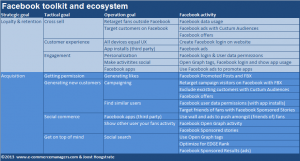Your guide through the content curation jungle
Absolutely great blogpost: Your guide through the content curation jungle
Absolutely great blogpost: Your guide through the content curation jungle
Viewsy – instore offline traffic analytics
E-commerce KPI comparison Facebook, Twitter and Pinterest traffic (Beautiful and useful infographic)
Some main points:
99 facts & stats about the future of business
Some examples:

(click to enlarge)
Opt-in’s: email is replaced by social media
Partnering with TripAdvisor brings relevance and reliability to linked cardmembers’ customer reviews on the TripAdvisor site.
The majority of cardmembers who have linked their cards to their social media profiles previously opted out of email.
Currently trialling ‘Tweet to Buy’.
I found this great article about Napoleon Bonaparte. I am a big fan of him.
Rapidity of movements.
“The strength of an army,
like the power in mechanics,
is estimated by multiplying
the mass by the rapidity …
Press on !” – Napoleon Bonaparte
Five principles guiding the development of his plans.
Before every campaign Napoleon considered all possible options. The Emperor wrote, “There is no man more pusillanimous than I when I am planning a campaign. I purposely exaggerate all the dangers and all the calamities that the circumstances make possible. I am in a thoroughly painful state of agitation. This does not keep me from looking quite serene in front of my entourage; I am like an unmarried girl laboring with child.”
In the months and weeks before operations actually commenced he would begin to collect information. In addition to reading an enormous number and variety of books bearing on the enemy and the theater of war, he studied the volumes of intelligence reports forwarded by the agents that he had scattered throughout Europe. He would pursue works of political history, accounts of the state of roads and bridges, reports on the politicians and generals, and even studied patterns of food stockpiling and distribution.
Social Login, E-Commerce and Conversion Rates
How Social Login Effects Ecommerce (Monetate Infographic)
Social Login Trends Across the Web for Q3 2013 (Janrain Infographic)
UX reasons to use Social Login
Business reasons to use Social Login
Source
Contrary opinions
Other (side) resources
E-commercemanagers.com heeft als missie om bedrijven en organisaties succesvoller te laten zijn in het digitaal geautomatiseerde tijdperk.
Wij geloven dat analyse en inzicht in de oorzaken van vraagstukken cruciaal zijn vervolgens oplossingen te implementeren die efficient, effectief en schaalbaar zijn.
Data, automatisering en personalisatie hebben daar in de meeste gevallen een belangrijke rol in.
Wij werken op een agile wijze met scrum technieken en proberen snel tot de kern te komen.
Schrijf u nu in voor de maandelijkse nieuwsbrief:
E-commercemanagers.com
⛾ Goudenregen 12
8141 XA HEINO
☎ 038-2340222
✉ info [at] e-commercemanagers.com
